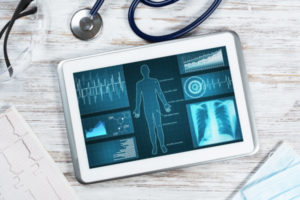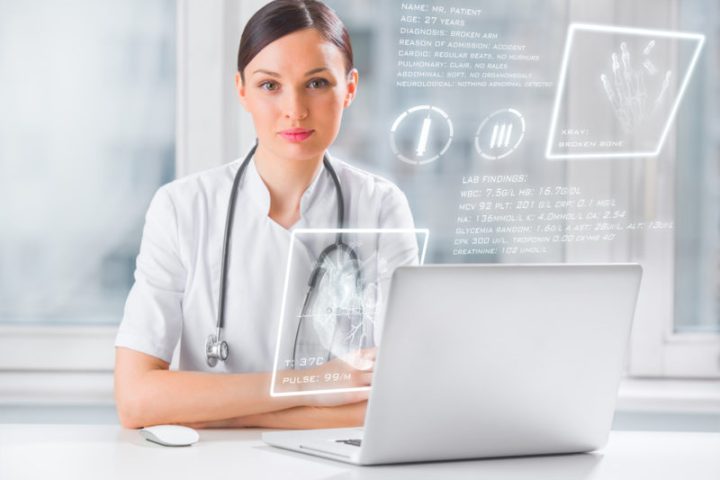Only a few industries in the world are targeted by cybercriminals as often as the healthcare industry. As a result, the damage to healthcare organizations and patient safety can be devastating. According to the U.S. Department of Health and Human Services, healthcare data breaches have increased over the past decade. Additionally, in 2021, more data breaches were reported than in any other year since records first started being collected and published.
According to the Health Insurance Portability and Accountability Act (HIPAA) Journal, there has been a total of 4,419 healthcare organization data breaches from 2009 through 2021. As a result, there was a loss, exposure, or theft of more than 314 million healthcare records containing sensitive patient data.
The Department of Health and Human Services also confirms that the number of data breaches in the healthcare industry has been steadily climbing. In 2018, healthcare data breaches of 500 or more records were being reported at around 1 per day. Fast forward four years to 2021, and the rate of exposed patient data has nearly doubled to 1.95 cases reported to Health and Human Services on a daily basis.
However, what can healthcare providers, healthcare organizations, and medical professionals do to protect their overall patient safety? How can your organization ensure that healthcare data isn’t available to an unauthorized third party?
It starts by understanding healthcare cybersecurity and how to mitigate the risk of an attack or data breach. Furthermore, knowing how to take the steps which ensure that your healthcare organization is not disclosing sensitive information to threat actors, or anyone who has the potential to impact your security and affect your organization’s patient privacy.
- What is Healthcare Cybersecurity?
- Why is Cybersecurity Important in the Healthcare Industry?
- What are Cybersecurity Threats in Healthcare?
- What are the Best Methods to Improve Cybersecurity in Healthcare Institutions?
- Review Your Medical Devices and Conduct Updates and Upgrades
- Train Your Employees and Team Members to Understand the Obvious Risks
- Emeritus Provides Effective Healthcare Cybersecurity Services
What is Healthcare Cybersecurity?
Healthcare cybersecurity boils down to the systems, software, updates, and tools you utilize to protect your healthcare organization’s intellectual property. Specifically, this includes your patient data.
It involves multiple levels of risk management throughout your software and operating systems, as these computer and operating systems are very complex. Additionally, it generally requires a team ofhealthcare technology experts to protect countless electronic health records and myriad of sensitive information. All confidential information can directly or indirectly impact patient safety.

Why is Cybersecurity Important in the Healthcare Industry?
Cybersecurity in healthcare is essential because of the sensitive data that makes healthcare organizations attractive to cybercriminals.
Many healthcare organizations have countless records that contain personally identifiable information or protected health information. This includes patients’ names, addresses, birthdates, social security numbers, the details of health plans, insurance information, and even payment information. Obtaining this readily available information through many healthcare systems allows cybercriminals to utilize, sell, and profit from patients’ data. Therefore, it can prove catastrophic for healthcare facilities, and any organization that provides medical services.
In addition, the sheer number of patients and individuals who can be affected is staggering. In one of the largest data breaches in history, an estimated 78,800,000 patient records were acquired through a 2015 hacking incident. Currently an estimated 314,063,186 patient records have been compromised and disclosed since 2009.
What are the Cybersecurity Threats in Healthcare?
The issue with cybersecurity in healthcare is that numerous connected medical devices are used daily to provide the best care possible to a healthcare organization’s patients.
These devices can range from the desktop computer network your staff uses throughout the day to the legacy systems that store electronically protected health information. Also, this includes mobile devices that allow practitioners remote access.
Countless devices use an online internet connection. Moreover, if some of these devices are outdated or not properly protected by technical safeguards, this massive amount of data is particularly vulnerable to cyber threats. Medical systems comprise of multiple working parts, and just one unprotected component of the medical devices that your organization uses can result in a massively heightened cyber risk.
Also, keep in mind, that in the past several years, the number of ways that healthcare organizations connect with their patients remotely has increased. With the onset of the Coronavirus pandemic in 2020, more medical facilities and their business partners have turned to online patient portals and virtual doctor appointments. Additionally, they use other readily available tools that reduce the number of in-person visits. However, this also enhances the convenience of accessing and sharing protected health information online.
This transformation into virtual medical care can easily increase the number of security incidents that impact your company. This is simply because hackers and cybercriminals now have more access points to obtain a patient’s protected health information.

What are the Best Methods to Improve Cybersecurity in Healthcare Institutions?
The silver lining is that healthcare organizations can take several steps to reduce their cyber risk and enhance their data protection. From familiarizing your organization with HIPAA privacy and HIPAA security rules to adapting broader security strategies across the board. Let’s explore some rough guidelines for enhancing your healthcare cybersecurity.
Have a Clear Understanding of the Laws and Regulations Regarding Healthcare Cybersecurity
Several laws and regulations that are in place (and which are constantly evolving) and are designed to protect a patient’s sensitive information.
The Health Insurance Portability and Accountability Act of 1996 (HIPAA) is arguably the foundation of these regulations. It is a federal law that requires the creation of national standards to protect sensitive patient health information from being disclosed without the patient’s consent or knowledge.
The Health Insurance Portability and Accountability Act was established in the 1990s and was clearly crafted before the internet era. However, its fundamentals remain the same and the law serves as a guideline for healthcare providers, healthcare plans, healthcare clearinghouses, and business associates. Additionally, this includes any organization that deals with health information. Understanding the Portability and Accountability Act and the associated HIPAA Security Rules and breach notification rules is paramount to any cybersecurity risk management strategy.
Another important federal guideline to reference is the Cybersecurity Act of 2015. After a noticeable rise in data breaches, Congress established the Healthcare Industry Cybersecurity (HCIC) Task Force to address the cybersecurity challenges the healthcare industry faced when securing and protecting itself against cybersecurity incidents. You can review the fundamentals of the act, and additional cybersecurity policies and regulations in pace here.
Conduct a Cyber Risk Assessment
A cybersecurity risk assessment is a key component in any healthcare organization’s risk management strategy. The modern medical industry employs medical devices throughout its operations at an approximate ratio of 5:1 compared to traditional business industries and their associated devices. This includes computers, mobile phones, and printers. An estimated 40% of medical devices use an online connection. This means they are potentially connected to inside and outside users, and this percentage is growing every year.
In a cyber risk assessment, a Managed Security Service Provider (MSSP) will evaluate and analyze an organization’s cybersecurity controls throughout all of their devices, software, and systems. Additionally, they will analyze their ability to prevent, detect, respond, and recover from cyberattacks.
This risk assessment is crucial to protecting all aspects of your sensitive patient data and will include the following:
- thorough examination of the devices you use
- the data that the devices are sharing
- the configuration of all devices
- the location of devices on a network
Also, many other attributes that will paint a crystal-clear picture of your organization’s protection against cybersecurity threats.
Create a Cybersecurity Policy for Your Healthcare Organization
A comprehensive cybersecurity plan for your company is essential for risk analyses and protecting your patient data as technology advances. It is a cornerstone of any risk management strategy.
Cybersecurity governance within your organization is a way of controlling the confidentiality, integrity, and availability of protected health information. The management and daily use of medical devices should use this policy . Including everything from onboarding through replacement and every procedure. This is important so that you have a best practices system in place that reduces your overall cybersecurity risks.
Review Your Medical Devices and Conduct Updates and Upgrades
Manufacturers of software, medical devices, apps, patient portals, and other internet-connected tools are constantly revising their programs and creating new versions and upgrades to stay ahead of cybercriminals.
As hackers find a new way to access a system, these manufacturers create constant fixes or adaptations to respond to the ingenious new cybersecurity threats. This is especially essential in the healthcare system.
Healthcare organizations use many devices at any time. This results in staff focusing on patient care rather than overall security. Additionally, it’s very easy for healthcare facilities of all sizes to run older versions of software or other devices suspectable to current cyber threats.
By enlisting a partner to monitor all your devices and operations, from your email platforms to the technical tools that monitor a patient’s health, you can ensure that your data is protected from new cyber threats as they surface.
Restrict and Evaluate Your Access
Healthcare facilities have dozens, hundreds, or even thousands of end-users connected to a single network or system. This is great news for cybercriminals. Since they only have to find a single weak link in a healthcare organization’s operations to access countless electronic healthcare records.
As such, let’s discover a few key strategies for your internal systems and programs. This information will go a long way in managing who can access this sensitive data.
- Create an automatic sign out for staff members, patients, etc. of all programs and devices after each use, with no ability to share user information.
- Adapt the “Principle of Least Privileges,” where your staff members are only given clearance to access the minimal amount of data required to perform their job functions.
- Enlist multi-factor authentication to access cloud-based systems.
- Require employees and business associates to update their passwords every six months for all devices and programs, including email platforms.
- Enlist web filtering software to block malicious website access in emails and other online platforms.
Train Your Employees and Team Members to Understand the Obvious Risks
One of the most effective ways cybercriminals accesses a broad system is by identifying a weak link in your personnel. In some of the biggest data breaches in history, a hacker could cause millions of dollars in damage with a single phone call.
The way this type of phishing scheme works is simple. A hacker will call or email an employee, pretending to be a member of an organization’s IT team. Cybercriminals can easily find information online via a LinkedIn page or Facebook account to make it seem like they are an official company source. After providing some convincing details about the hacker’s ties to the company or the employee, the hacker then directs the employee to click on a link. Then, they enter their username and password for a particular IT task. For example, they request them to update their security or network access. However, the link that is provided is fake. Therefore, the hacker now has access to the lone employee’s username and password, they can connect to an entire data system.
Tales like these are common. This is just one example of how your data can be compromised if your team is not informed and unaware of red flags. Training sessions and updates are instrumental in ensuring that everyone in your organization stays well-informed of potential cyberattacks. Therefore, this will help protect your overall operations.
Remember that this is just the start of the must-do fundamentals when it comes to managing access for your staff members and partners. Additionally, this is important for a medical network security partner that will conduct all these operations and miles more to ensure that your data is safe and protected.
Emeritus Provides Effective Healthcare Cybersecurity Services
Providing effective protection against cyberattacks can be difficult for healthcare organizations of all sizes. This is simply because even the biggest healthcare facility traditionally does not have the budget to enlist an entire team of experts that can thoroughly and routinely comb through every device that is connected to the internet.
However, this is where Emeritus can step in and provide a cost-effective and thorough cybersecurity solution that protects every corner of your operations.
Emeritus offers a free cyber risk assessment, an essential first step in any risk management strategy. This assessment provides a report on your vulnerabilities across the board. Also, it will give your organization a deeper understanding of your risk levels and what steps you can take to have the best protection.
You don’t have to do it alone when protecting your organization from a costly and devastating data breach. At Emeritus, we are cybersecurity experts. Specifically we are experts in the healthcare realm. Ultimately this can be more complex and costly risks than any other industry. This makes us uniquely positioned to provide the best services possible when it comes to your security.
Cybercrime in the healthcare industry is on the rise and is only going to increase in the years to come. This is because technological advances will offer new ways for medical providers to provide better service to their patients. However, with Emeritus at your side, you can protect your data. Also, you can ensure that your organization isn’t a victim to a long list of healthcare organizations around the world that have been compromised and devastated by a data breach.






